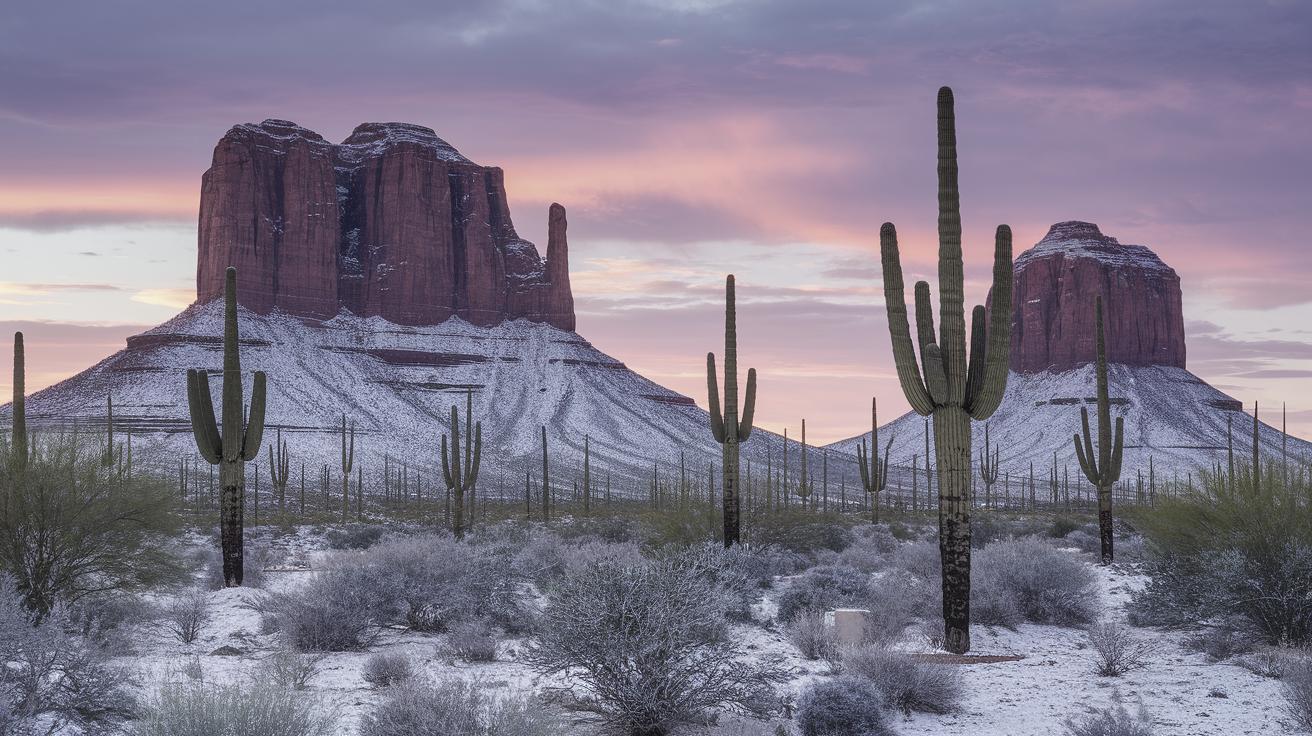Does It Snow in Arizona?
When you picture Arizona, you might envision vast deserts, towering cacti, and sun-drenched landscapes. However, the state is more diverse than many realize, offering a variety of climates that include snowy wonderlands during the winter months. In this article, we will explore the snowy side of Arizona, delving into popular snow spots like the Arizona Snowbowl, understanding the conditions needed for snowfall, and examining some fascinating historical snowfall events in Phoenix, Arizona’s capital. By the end of this exploration, you will see a side of Arizona that defies its sun-soaked stereotype.
Snow in Arizona
Contrary to popular belief, snow is not an uncommon occurrence in certain parts of Arizona. The state’s diverse topography means that while the lower desert areas like Phoenix and Tucson experience mild winters, the higher elevations are often blanketed in snow. The northern part of the state, particularly around Flagstaff, enjoys a winter wonderland each year with enough snow to support a bustling winter sports industry.
Flagstaff, located in the northern part of Arizona, receives an average of about 100 inches of snow per year. This makes it one of the snowiest cities in the United States. The town’s proximity to the San Francisco Peaks, which reach elevations over 12,000 feet, ensures a regular supply of snow during the winter months, drawing winter sports enthusiasts from across the region.
ARIZONA SNOWBOWL
The Arizona Snowbowl is one of the premier destinations for winter sports in the state. Nestled in the San Francisco Peaks, just a short drive from Flagstaff, it offers a variety of winter activities including skiing, snowboarding, and snowshoeing. The resort boasts a range of runs suitable for all levels, from beginners to advanced skiers and snowboarders.
Since its opening in 1938, the Arizona Snowbowl has been a beloved destination for both locals and visitors. The resort also offers lessons and equipment rentals, making it accessible for families and individuals looking to try their hand at winter sports for the first time. Beyond skiing, the breathtaking views of the surrounding mountains covered in snow provide an unforgettable experience.
How cold does it have to be to snow?
Snowfall generally occurs when temperatures are at or below freezing, around 32 degrees Fahrenheit (0 degrees Celsius). However, snow can still occur when temperatures hover slightly above freezing if the atmosphere is cold enough at higher altitudes. In Arizona, the higher elevations and mountainous regions provide the right conditions for snow even when lower areas remain snow-free.
The presence of moisture is also crucial for snow formation. Arizona, with its predominantly arid climate, relies on winter storms that sweep in from the Pacific to deliver the necessary moisture. As these storms move over the higher terrain, they drop snow instead of rain, particularly around elevated locales such as the Mogollon Rim and the San Francisco Peaks.
When was the last time it snowed in Phoenix?
While snow in Phoenix is a rare phenomenon, it does happen on occasion. The last notable instance of snowfall in Phoenix occurred on February 21, 2019. During this event, residents in the outskirts and at higher elevations experienced light snowfall, while central Phoenix saw a dusting that melted as quickly as it appeared.
Such snow events in Phoenix are brief and don’t typically lead to significant accumulation due to the city’s warm ground temperatures and rapid melting. However, these moments capture the imagination and curiosity of residents who are unaccustomed to snow in an arid, sun-drenched environment.
What’s the most it has ever snowed in Phoenix?
The heaviest recorded snowfall in Phoenix occurred on January 20, 1933, which remains a day of historical interest for many weather enthusiasts. On this day, Phoenix received approximately one inch of snow, a substantial amount given the city’s typically warm climate. It was a unique weather event that residents still talk about.
This record highlights the rarity of substantial snowfall in Phoenix and serves as a reminder of the city’s predominantly warm and dry climate. Despite these historic instances, Phoenix remains largely free from the snow so characteristic of its northern regions.
Summary of Main Points
| Topic | Summary |
|---|---|
| Snow in Arizona | Northern Arizona experiences regular snowfall, especially in Flagstaff, which receives an average of 100 inches annually. |
| ARIZONA SNOWBOWL | A popular destination for winter sports, located in the San Francisco Peaks, it attracts visitors for skiing and snowboarding. |
| How cold does it have to be to snow? | Temperatures at or below 32°F (0°C) are necessary, and Arizona’s higher elevations facilitate such conditions. |
| When was the last time it snowed in Phoenix? | February 21, 2019, marked the last notable snowfall in Phoenix, characterized by light and fleeting snow. |
| What’s the most it has ever snowed in Phoenix? | The heaviest snowfall in Phoenix history occurred on January 20, 1933, reaching about one inch. |


